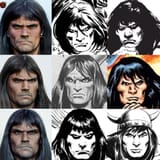Search Results
7/1/2025, 7:38:12 AM
>>509191815
>Though several later authors have referred to Conan as "Germanic-looking," Howard imagined the Cimmerians as a proto-Celtic people with mostly dark hair and blue or grey eyes. Racially the Cimmerians to which Conan belongs are descendants of the Atlanteans, though they do not remember their ancestry. In his pseudo-historical essay "The Hyborian Age", Howard describes how the people of Atlantis (the land where his character Kull originated) had to move east after a great cataclysm changed the face of the world and sank their island, settling where northern Scotland and Norway would eventually be located. In the same work, Howard also described how the Cimmerians eventually moved south and east after the age of Conan
>Ancient Ireland had Conann the barbarian, for real, except instead of calling him a barbarian, the historical accounts called him a Fomorian, or a giant. The Fomorians of legend were one of the giant races of the Old World. Nobody knows when they arrived in Ireland, because it seemed as if they’d always been there
>Conann was king of the Fomorians. Like most of the people in his day, instead of referring to him with a first and last name, he was known by something in his life that set him apart — Conann of Tory Island, for the island he lived on. Another Fomorian was Balor of the Evil Eye, who married Cethlenn of the Crooked Teeth, so you can see how names were adapted when you reached adulthood
>Their lifestyle was barbaric. Fomorians did not build, or produce. They stole; they demanded tribute; they ruled with an iron fist; and they were pirates. Few stories come down from Celtic legends that depict the Fomorian giants in a positive light. They even sacrificed Humans in the Samhain fires, or cut off their noses for not paying taxes. Fomorian giants were bloody and brutal
>Conan the Barbarian of pulp fiction fame, also known as Conan the Cimmerian, had a lot in common with Conann of Tory Island
>Though several later authors have referred to Conan as "Germanic-looking," Howard imagined the Cimmerians as a proto-Celtic people with mostly dark hair and blue or grey eyes. Racially the Cimmerians to which Conan belongs are descendants of the Atlanteans, though they do not remember their ancestry. In his pseudo-historical essay "The Hyborian Age", Howard describes how the people of Atlantis (the land where his character Kull originated) had to move east after a great cataclysm changed the face of the world and sank their island, settling where northern Scotland and Norway would eventually be located. In the same work, Howard also described how the Cimmerians eventually moved south and east after the age of Conan
>Ancient Ireland had Conann the barbarian, for real, except instead of calling him a barbarian, the historical accounts called him a Fomorian, or a giant. The Fomorians of legend were one of the giant races of the Old World. Nobody knows when they arrived in Ireland, because it seemed as if they’d always been there
>Conann was king of the Fomorians. Like most of the people in his day, instead of referring to him with a first and last name, he was known by something in his life that set him apart — Conann of Tory Island, for the island he lived on. Another Fomorian was Balor of the Evil Eye, who married Cethlenn of the Crooked Teeth, so you can see how names were adapted when you reached adulthood
>Their lifestyle was barbaric. Fomorians did not build, or produce. They stole; they demanded tribute; they ruled with an iron fist; and they were pirates. Few stories come down from Celtic legends that depict the Fomorian giants in a positive light. They even sacrificed Humans in the Samhain fires, or cut off their noses for not paying taxes. Fomorian giants were bloody and brutal
>Conan the Barbarian of pulp fiction fame, also known as Conan the Cimmerian, had a lot in common with Conann of Tory Island
Page 1
